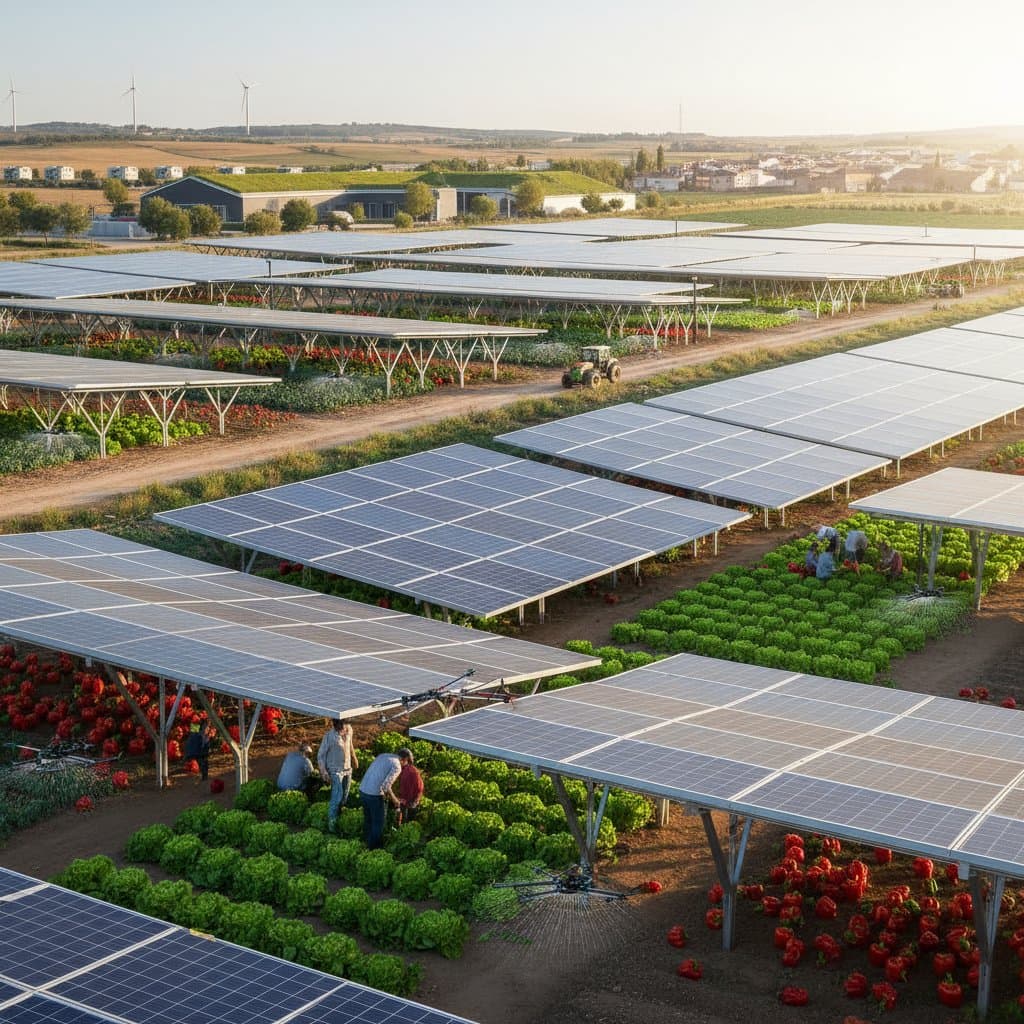Agrivoltaics: Solar Farms Producing Power and Crops in 2025
Solar farms extend beyond electricity generation alone. In rural and suburban settings, these installations now yield both renewable energy and viable crops. Known as agrivoltaics or dual-use solar, this method permits photovoltaic panels and vegetation to occupy the same terrain. The result offers enhanced land utilization, additional revenue streams for farmers, and alignment with broader clean energy objectives.
The principle relies on strategic design. Panels elevate to greater heights or widen in spacing to permit sunlight penetration to underlying plants. Farmers select shade-tolerant varieties such as vegetables or grains. Electricity flows to the grid from the panels, while crops mature beneath. Effective implementations reveal mutual benefits: partial shade mitigates plant heat stress, and vegetation cools panels to elevate their performance.
Core Principles of Agrivoltaics
Agrivoltaics involves integrating solar arrays with active farming. This preserves agricultural activity on land that might otherwise shift solely to energy production. Studies from the U.S. Department of Energy's National Renewable Energy Laboratory indicate that such systems elevate overall land output by merging solar energy production with crop harvests.
Principal advantages encompass:
- Enhanced land efficiency, as a single area delivers food and power
- Decreased water evaporation, with shaded soil holding moisture extended periods
- Greater crop durability amid elevated temperatures
- Sustained financial security via power purchase agreements or leasing arrangements
Farmers adopting these configurations frequently note diminished losses during peak heat. Shade-adapted options like lettuce, spinach, and berries thrive in dappled light. Raised panels also accommodate livestock grazing, which cuts maintenance expenses and enriches soil through natural processes.
Implementing Dual-Use Solar Systems
Establishing a dual-use solar farm commences with thorough site analysis. Engineers evaluate soil quality, drainage patterns, and sunlight availability. Arrays then configure with elevations or spacings suited to chosen crops or grazing. Structures endure environmental stresses while permitting machinery passage.
Essential elements comprise:
- Photovoltaic panels secured on adaptable racking systems
- Inverters transforming direct current into alternating current
- Protective fencing or barriers for livestock integration
- Monitoring tools assessing energy output and site conditions
Coordination with local regulatory bodies precedes construction. Requirements for permits, setbacks, and zoning differ across locations. Licensed electrical professionals manage wiring, grounding, and grid connections to comply with standards. Property owners avoid any alterations to solar components without expert involvement.
Prioritizing Safety in Electrical Design
Proximity of electrical systems to irrigation introduces risks from moisture. Ensure junction boxes and conduit fittings suit outdoor exposure. Secure all connections against weather and establish proper grounding. Address any water accumulation near supports promptly to avert corrosion or faults.
Qualified electricians alone perform installations and checks on:
- Buried conduit pathways to inverters
- Ground fault circuit interrupter and arc fault circuit interrupter protections
- Grounding conductors and bonding elements
- Disconnect switches and overcurrent safeguards
Automatic shutdowns activate during ground or arc faults. Persistent activations signal underlying issues like faulty wiring. Engage a certified solar electrician without delay in such scenarios. Refrain from accessing live components or repeated breaker resets.
Broader Economic and Environmental Effects
Dual-use solar fosters energy self-sufficiency and rural vitality. Farms decrease dependence on fossil fuels and trim operational expenses. Landowners often lease portions to developers, securing income alongside continued farming. This preserves acreage from conversion or disuse.
Ecological gains feature:
- Diminished greenhouse gas outputs from clean power sources
- Minimized soil erosion through under-panel cover crops
- Expanded habitats for pollinators via native vegetation
- Tempered local temperatures via plant transpiration
Agricultural university investigations confirm superior soil hydration and reduced watering needs in agrivoltaic areas versus exposed fields. These findings position agrivoltaics as a pathway to resilient agriculture without yield compromises.
Strategies for Project Planning and Upkeep
Prospective adopters initiate with a comprehensive feasibility assessment. Analyze solar exposure, suitable crops, and grid connectivity. Select panel configurations compatible with current farm tools.
Ongoing maintenance entails:
- Examining mounts and fasteners for wear or shifts
- Reviewing inverter interfaces for alerts
- Clearing panels gently to eliminate accumulations
- Observing plant development and refining watering schedules
- Logging metrics on energy generation and harvest volumes
Trim encroaching foliage to safeguard wiring and frameworks. Avoid directing water toward electrical areas.
Advancing Integrated Land Solutions
Agrivoltaics reshapes perspectives on renewable energy and food resilience. It converts marginal lands into multifaceted assets yielding power and produce.
PhillyGoessolar.com advises consulting certified installers, agricultural experts, and regulatory officials prior to projects. Well-engineered setups endure for decades, providing dependable energy and bolstering regional agriculture.
Actionable Steps for Implementation
- Consult county planning departments on zoning and approvals
- Secure evaluations from accredited solar specialists
- Collaborate with extension services on crop or grazing strategies
- Evaluate funding and leasing proposals from various providers
- Arrange yearly reviews by licensed electricians
Integrating electrical precision with farming knowledge, dual-use solar fortifies energy networks and nourishment chains. Thoughtful preparation and expert guidance yield enduring benefits for operations, locales, and posterity.
